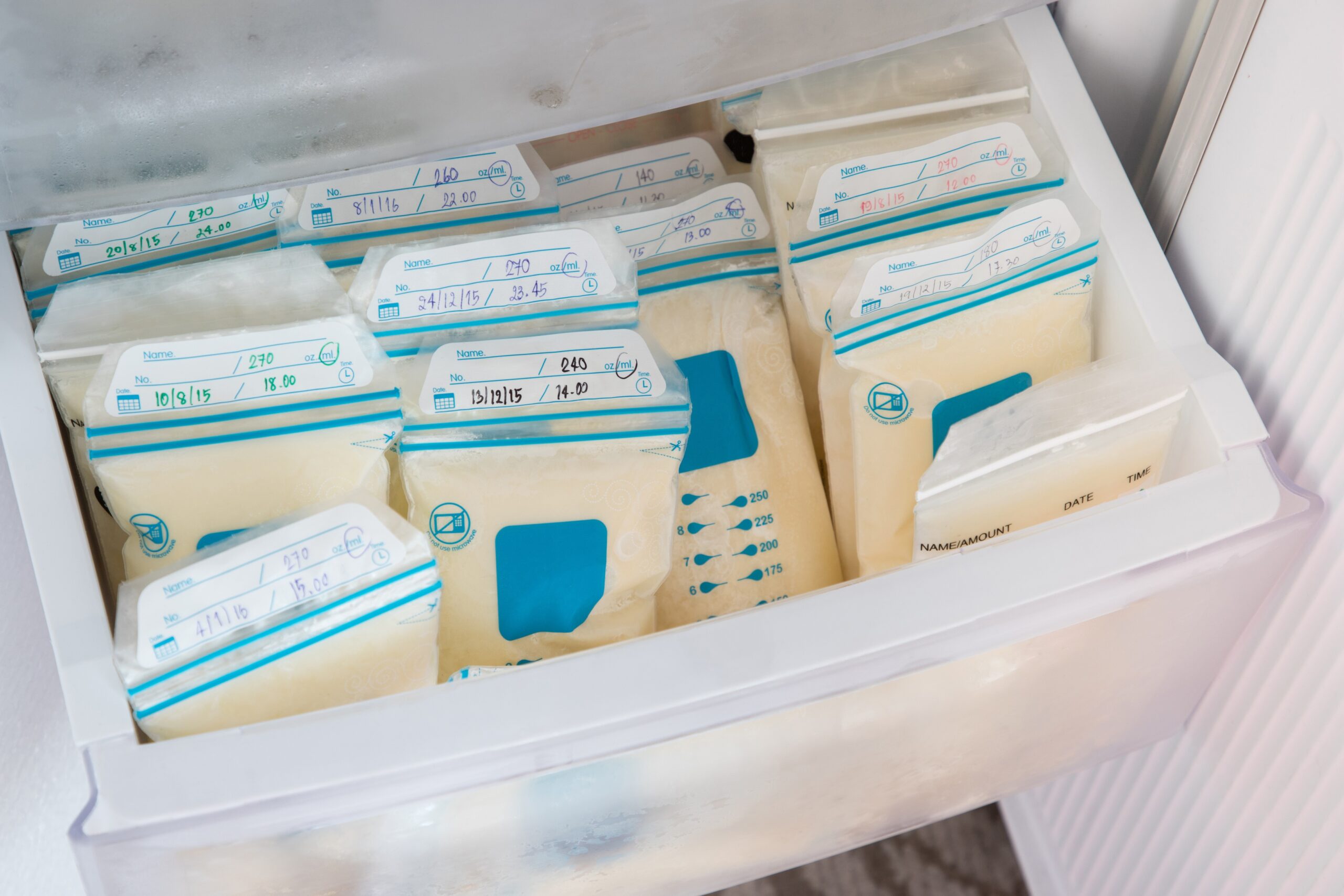For future parents who find themselves separated by long distances from their surrogate mother, the transportation of breast milk can present a unique challenge.
In this blog, we’ll explain the process of shipping breast milk in surrogacy so that surrogate mothers know how to do so safely, and long-distance parents can ensure their newborns receive this precious nourishment.
How to Get Breast Milk Ready for Shipping
Shipping breast milk, especially over long distances, requires planning, safety protocols, and clear communication among all parties involved. Long-distance intended parents, separated by geographic distance from their surrogate, must entrust the surrogate mother with the responsibility of shipping breast milk for their newborn. The logistics involve the physical transportation as well as consideration for the emotional dynamics.
Proper Storage and Handling
The journey of shipping breast milk as a surrogate begins with the proper storage and handling of the milk. breast milk should be collected, stored, and maintained at the ideal temperature for its nutritional integrity. Here are the stops to follow for handling and storing breast milk for transport:
- Collection and Storage of Breast Milk: Ensure that the breast milk is collected in clean containers designed for freezing, such as breast milk storage bags or containers. Label each container with the date of expression to maintain freshness.
- Maintain a Freezing Temperature: Store the breast milk in a dedicated freezer at a temperature of -20°C (-4°F) or colder. This helps preserve its nutritional value.
- Use Sterile Equipment: Always use clean, sterilized breast pumps and containers to express and collect the milk. Maintaining strict hygiene is essential to prevent contamination.
Packaging the Milk for Shipping
Choose the right packaging materials to preserve your breast milk during transit. We recommend the following packaging materials:
- Insulated Cooler Bag or Box: Invest in a high-quality insulated cooler bag or box with sufficient space to accommodate your breast milk containers and ice packs.
- Bubble Wrap or Foam: Wrap each breast milk container with bubble wrap or foam for added insulation and protection against potential rough handling during shipping.
- Resealable Storage Bags: Place breast milk containers in a resealable plastic bag before adding them to the insulated cooler. This offers an extra layer of protection against leaks.
- Disposable Gloves and Sanitizing Wipes: Keep disposable gloves and sanitizing wipes on hand to maintain hygiene while handling the breast milk.
Labeling and Documenting Breast Milk Shipments
Clear labeling and meticulous documentation help ensure the smooth handling of breast milk, both in transit and upon arrival.
- Clear Labeling: Each breast milk container should be labeled with the date of expression, the quantity of milk, and the surrogate mother’s name. This helps in tracking and using the milk in the order it was expressed.
- Shipping Instructions: Attach a note to the shipment with clear instructions for handling the breast milk. Emphasize the importance of maintaining a frozen temperature throughout transit.
- Documentation: Keep records of the shipment, including tracking numbers, courier contact information, and any communication related to the shipment.
Maintaining the Milk’s Temperature During Transit
Maintaining the breast milk’s temperature during transit is critical to ensuring the quality and safety of the milk. Follow these instructions to make sure the temperature doesn’t deviate in transit:
- Choose a Reliable Courier Service: Select a courier experienced in shipping breast milk or medical supplies. Ensure they are aware of the importance of maintaining a frozen temperature.
- Expedited Shipping: Ship the breast milk using an overnight or expedited shipping method to minimize transit time.
- Insulated Packaging: Place the wrapped breast milk containers inside the insulated cooler bag or box. Add enough ice packs to maintain a freezing temperature throughout transit.
- Monitoring the Shipment: Keep a close eye on the shipment’s progress through tracking information. This allows you to monitor its journey and take action if any delays or issues arise.
- Quick Reception: Once the breast milk arrives at its destination, transfer it to a freezer immediately. Check for any damage during transit and ensure the temperature has been maintained.
Shipping breast milk might be a logistical challenge, but with careful planning and attention to detail, you can ensure that your baby continues to receive the best nourishment, even when distance separates the surrogate and parents.

How to Select a Shipping Method
Choosing the right shipping method for breast milk for surrogacy involves comparing factors such as cost, reliability, and delivery time. Here are several factors surrogates and parents can consider to help you make the right choice.
- Cost: Keep in mind that while some options may be cost-effective, others prioritize safety and convenience.
- Reliability: Look for tracking capabilities and guarantees of timely delivery.
- Delivery Time: Assess how quickly you need the breast milk to reach its destination.
- Safety and Quality: Ensure that the chosen method adheres to proper storage and handling protocols to maintain the milk’s integrity.
- Convenience: Consider the level of support provided by the chosen shipping method. Specialized milk shipping companies may offer additional resources and materials to make the process smoother.
In the end, the choice of shipping method should align with your specific needs, preferences and circumstances.
Types of Shipping Companies
Whether you opt for express courier services, specialized milk shipping companies, or explore alternative options, the goal is to ensure the surrogate baby receives the nourishment they need safely and on time, even when miles separate you.
1. Express Courier Services
- Cost: Express courier services, such as FedEx or UPS, are readily available and offer a range of shipping options. The cost can vary depending on the speed of delivery and the distance involved. While they are convenient, faster shipping options can be more expensive.
- Reliability: Courier services are known for their reliability and tracking capabilities. You can monitor your shipment’s progress in real-time, providing peace of mind.
- Delivery Time: Depending on the chosen service level, express courier services can provide next-day or 2 – 3-day delivery. This option is ideal if you need breast milk to reach its destination quickly.
2. Specialized Milk Shipping Companies
- Cost: Specialized milk shipping companies, like Milk Stork, are designed specifically for shipping breast milk. While they offer specialized services, they can be more expensive than traditional courier services.
- Reliability: These companies are experienced in handling breast milk shipments and prioritize safety and quality. They often provide extra packaging materials and guidance to ensure the milk arrives in optimal condition.
- Delivery Time: Delivery times with specialized milk shipping companies can vary, but they are usually within a reasonable timeframe. They may offer overnight or 2 – 3 day options, depending on your needs.
3. Online Breast-Milk Donation Communities
- Cost: Some online communities facilitate breast milk donation and sharing. In some cases, you may find individuals willing to donate or sell their excess breast milk. The cost can vary widely, from minimal to negotiated rates.
- Reliability: The reliability of online communities can be less predictable than established courier services or specialized milk shipping companies. It’s crucial to thoroughly vet the source and ensure they follow proper storage and handling protocols.
- Delivery Time: Delivery times in online communities depend on individual arrangements and location. It may not be as fast as express courier services.
4. Personal Delivery
- Cost: If possible, some long-distance intended parents may opt for personal delivery when visiting their surrogate. This option minimizes shipping costs but is only feasible if there’s a physical presence near the surrogate mother.
- Reliability: Personal delivery ensures direct control over the breast milk’s safety and temperature. However, it relies on the ability to travel to the surrogate’s location.
- Delivery Time: The delivery time for personal delivery depends on your travel plans and proximity to the surrogate mother.
Emotional Aspect of Shipping Breast Milk
Shipping breast milk can evoke a range of emotions for you as the surrogate or intended parents. Parents may feel separation anxiety, longing and concern about the well-being of their baby. Surrogate mothers may have emotional attachments to the process, as breastfeeding is a deeply intimate experience.
Be sure to recognize and accept your feelings around the complexities of milk sharing, as acknowledging your emotions is the first step toward managing them. If needed, reach out to support networks, including friends, family or support groups to share your feelings with those who understand your unique journey can provide comfort and validation.
Consider seeking guidance from a counselor or therapist who specializes in surrogacy or family dynamics if needed, as they can help you process your emotions and develop coping strategies.
Tips for Communication and Building Trust
Effective communication and trust between intended parents and the surrogate are paramount, especially related to an activity as sensitive as shipping breast milk. Openly discuss your expectations and intentions regarding breast-milk sharing to ensure that both parties are on the same page. Keep an open dialogue about your feelings, concerns and any updates related to the breast milk shipping process.
Intended parents should also express their gratitude and appreciation for the surrogate’s contribution. Meanwhile, if any concerns or questions arise during the breast milk shipping process, address them promptly and constructively with open, respectful dialogue.
Frequently Asked Questions
If you still have questions about how to ship breast milk for surrogacy, consider some of these common questions we hear from our surrogate mothers and long-distance intended parents.
Why is shipping breast milk necessary?
Shipping breast milk becomes essential for long-distance intended parents because it allows them to provide their surrogate baby with the benefits of breast milk from the surrogate mother. Breast milk is not only a source of nutrition but also a means of enhancing the baby’s immunity and overall health.
What are the benefits of breast milk to a surrogate baby?
Breast milk offers a balanced blend of nutrients to promote healthy growth and development for infants, is rich in antibodies and immune-system boosting factors that protect the baby against infections and diseases, and is also easier for infants to digest than formula, reducing the risk of digestive issues such as colic and constipation. Some studies also suggest that breastfed babies may have cognitive advantages, although more research is needed in this area.
Complete Your Surrogacy Journey with Joy of Life
If you have questions about surrogacy, the team at Joy of Life is here to help. We are a compassionate surrogacy agency based in California that’s committed to creating life, fostering joy and nurturing dreams. Our team has experience in the clinical, psychological and legal aspects of surrogacy. We also reward surrogate mothers with competitive compensation as well as other advantages. Contact us to become a surrogate or intended parent today!










